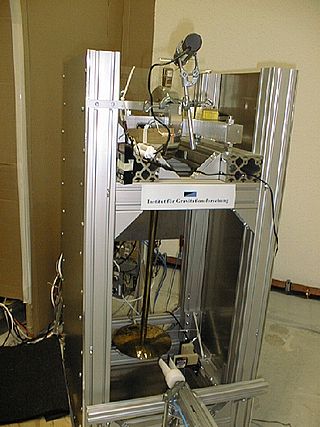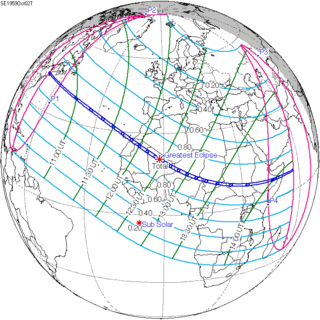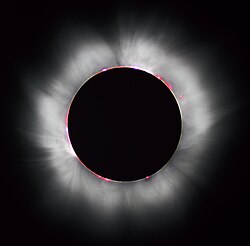
The gravitational constant, denoted by the capital letter G, is an empirical physical constant involved in the calculation of gravitational effects in Sir Isaac Newton's law of universal gravitation and in Albert Einstein's theory of general relativity.
The following is a timeline of gravitational physics and general relativity.
In physics, there are four observed fundamental interactions that form the basis of all known interactions in nature: gravitational, electromagnetic, strong nuclear, and weak nuclear forces. Some speculative theories have proposed a fifth force to explain various anomalous observations that do not fit existing theories. The characteristics of this fifth force depend on the hypothesis being advanced. Many postulate a force roughly the strength of gravity with a range of anywhere from less than a millimeter to cosmological scales. Another proposal is a new weak force mediated by W′ and Z′ bosons.

Maurice Félix Charles Allais was a French physicist and economist, the 1988 winner of the Nobel Memorial Prize in Economic Sciences "for his pioneering contributions to the theory of markets and efficient utilization of resources", along with John Hicks and Paul Samuelson, to neoclassical synthesis. They formalize the self-regulation of markets, which Keynes refuted but reiterated some of Allais's ideas.

The equivalence principle is the hypothesis that the observed equivalence of gravitational and inertial mass is a consequence of nature. The weak form, known for centuries, relates to masses of any composition in free fall taking the same trajectories and landing at identical times. The extended form by Albert Einstein requires special relativity to also hold in free fall and requires the weak equivalence to be valid everywhere. This form was a critical input for the development of the theory of general relativity. The strong form requires Einstein's form to work for stellar objects. Highly precise experimental tests of the principle limit possible deviations from equivalence to be very small.
The Pioneer anomaly, or Pioneer effect, was the observed deviation from predicted accelerations of the Pioneer 10 and Pioneer 11 spacecraft after they passed about 20 astronomical units (3×109 km; 2×109 mi) on their trajectories out of the Solar System. The apparent anomaly was a matter of much interest for many years but has been subsequently explained by anisotropic radiation pressure caused by the spacecraft's heat loss.

Gravimetry is the measurement of the strength of a gravitational field. Gravimetry may be used when either the magnitude of a gravitational field or the properties of matter responsible for its creation are of interest. The study of gravity changes belongs to geodynamics.
In the 19th century, the theory of the luminiferous aether as the hypothetical medium for the propagation of light waves was widely discussed. The aether hypothesis arose because physicists of that era could not conceive of light waves propagating without a physical medium in which to do so. When experiments failed to detect the hypothesized luminiferous aether, physicists conceived explanations for the experiments' failure which preserved the hypothetical aether's existence.
Tests of general relativity serve to establish observational evidence for the theory of general relativity. The first three tests, proposed by Albert Einstein in 1915, concerned the "anomalous" precession of the perihelion of Mercury, the bending of light in gravitational fields, and the gravitational redshift. The precession of Mercury was already known; experiments showing light bending in accordance with the predictions of general relativity were performed in 1919, with increasingly precise measurements made in subsequent tests; and scientists claimed to have measured the gravitational redshift in 1925, although measurements sensitive enough to actually confirm the theory were not made until 1954. A more accurate program starting in 1959 tested general relativity in the weak gravitational field limit, severely limiting possible deviations from the theory.
General relativity is a theory of gravitation that was developed by Albert Einstein between 1907 and 1915, with contributions by many others after 1915. According to general relativity, the observed gravitational attraction between masses results from the warping of space and time by those masses.
In theoretical astrophysics, the Nordtvedt effect refers to the relative motion between the Earth and the Moon that would be observed if the gravitational self-energy of a body contributed differently to its gravitational mass than to its inertial mass. If observed, the Nordtvedt effect would violate the strong equivalence principle, which indicates that an object's movement in a gravitational field does not depend on its mass or composition. No evidence of the effect has been found.
The term gravitational shielding refers to a hypothetical process of shielding an object from the influence of a gravitational field. Such processes, if they existed, would have the effect of reducing the weight of an object. The shape of the shielded region would be similar to a shadow from the gravitational shield. For example, the shape of the shielded region above a disk would be conical. The height of the cone's apex above the disk would vary directly with the height of the shielding disk above the Earth. Experimental evidence to date indicates that no such effect exists. Gravitational shielding is considered to be a violation of the equivalence principle and therefore inconsistent with both Newtonian theory and general relativity.
The flyby anomaly is a discrepancy between current scientific models and the actual increase in speed observed during a planetary flyby by a spacecraft. In multiple cases, spacecraft have been observed to gain greater speed than scientists had predicted, but thus far no convincing explanation has been found. This anomaly has been observed as shifts in the S-band and X-band Doppler and ranging telemetry. The largest discrepancy noticed during a flyby has been 13.46 mm/s.

The paraconical pendulum is a type of pendulum invented in the 1950s by Maurice Allais, a French researcher. During the 1950s, Maurice Allais conducted six marathon series of long-term observations, during each of which his team manually operated and manually monitored his pendulum non-stop over about a month. The objective was to investigate possible changes over time of the characteristics of the motion, hypothesized to yield information about asymmetries of inertial space.
The Eötvös experiment was a famous physics experiment that measured the correlation between inertial mass and gravitational mass, demonstrating that the two were one and the same, something that had long been suspected but never demonstrated with the same accuracy. The earliest experiments were done by Isaac Newton (1642–1727) and improved upon by Friedrich Wilhelm Bessel (1784–1846). A much more accurate experiment using a torsion balance was carried out by Loránd Eötvös starting around 1885, with further improvements in a lengthy run between 1906 and 1909. Eötvös's team followed this with a series of similar but more accurate experiments, as well as experiments with different types of materials and in different locations around the Earth, all of which demonstrated the same equivalence in mass. In turn, these experiments led to the modern understanding of the equivalence principle encoded in general relativity, which states that the gravitational and inertial masses are the same.
Erwin Joseph Saxl was a physicist and inventor. He was born in Vienna in 1904 and received his Ph.D. there in 1927. In the late 1920s he emigrated to the United States. In 1935 he founded the Saxl Instrument Company, which designed and manufactured tension meters for use in the textile industry, and later in other industries. The company, which Saxl ran jointly with his wife, Lucretia Hildreth Saxl, from their home in Harvard, Massachusetts, was renamed Tensitron in 1953. Saxl is reported as having stated that he worked under Albert Einstein. He died in 1981.

Mildred Allen was an American physicist.

A total solar eclipse occurred on October 2, 1959. A solar eclipse occurs when the Moon passes between Earth and the Sun, thereby totally or partly obscuring the image of the Sun for a viewer on Earth. A total solar eclipse occurs when the Moon's apparent diameter is larger than the Sun's, blocking all direct sunlight, turning day into darkness. Totality occurs in a narrow path across Earth's surface, with the partial solar eclipse visible over a surrounding region thousands of kilometres wide. Totality was visible from northeastern Massachusetts and the southern tip of New Hampshire in the United States, Canary Islands, Morocco, Spanish Sahara including the capital city Laayoune, French Mauritania, Mali Federation, French Niger, British Nigeria, British Cameroons and French Cameroons, French Chad including the capital city Fort-Lamy, French Central Africa, Sudan, Ethiopia, and the Trust Territory of Somaliland.
Jens Horst Gundlach is a German physicist.

The Lunar Surface Gravimeter (LSG) was a lunar science experiment that was deployed on the surface of the Moon by the astronauts of Apollo 17 on December 12, 1972. The LSG was conceived by its principal investigator Joseph Weber. Weber proposed a number of experimental methods for the detection of gravitational waves, and would go on to be described as the "founding father" of gravitational wave detection. The experiment aimed to measure changes in the local gravitational strength on the Moon's surface through the use of a gravimeter. These measurements were intended to provide insight into the internal structures of the Moon as it tidally deformed due interaction with the gravitational fields of the Earth and Sun. In addition the experiment hoped to contribute experimental evidence of the existence of gravitational waves.












